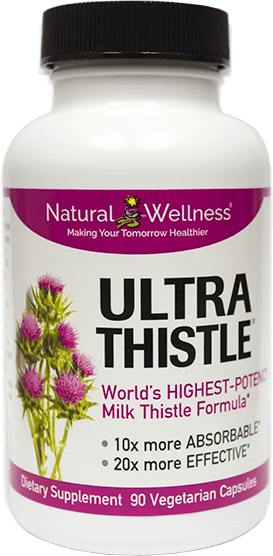Siliphos® - Pharmacology and Mechanism of Action

SILIPHOS®, the active ingredient in UltraThistle, is to be considered a natural vehicle of silybin, the active botanical ingredient. SILIPHOS® allows silybin to reach the target organ, the liver, in concentrations which are reported to be effective in several models of liver intoxication 11, 12 (Fig. 5) and to fit with the most important molecular mechanisms observed in vitro, such as the antioxidant 13-16 (Fig.6, Fig.7) and the stimulation of protein synthesis in hepatocytes 17 (Fig.8).
Toxicology
SILIPHOS® was shown to be well tolerated in acute and long-term toxicity tests in rodents (Table 1) and in primates up to oral doses of 2000 mg/kg (as silybin). The excellent tolerability of this complex was confirmed in volunteers at dosage up to 360 mg p.o. (as silybin) t.i.d. for three weeks. 6
Pharmacokinetics
As demonstrated by pharmacokinetic studies in comparison with free silybin and silymarin, SILIPHOS® represents the most absorbable form of silybin known until now. In rats, after oral administration of 200 mg/kg of silybin, the plasma levels of this drug and its conjugated metabolites were below the analytical detection limit, while, after oral administration of SILIPHOS® (200 mg/kg as silybin) the plasma levels of silybin (free and total) were easily measurable (Fig. 2). Furthermore, after oral administration of SILIPHOS®, the biliary elimination of silybin was not complete at 24 h and accounted for about 3.7% of the administered dose (Fig. 3). The compound was rapidly excreted in urine where at 72 h the amount recovered accounted for about 3.3% (Fig. 4). After administration of uncomplexed silybin, biliary and urinary elimination accounted for only 0.001% and 0.032%, respectively.7
The improvement of the oral bioavailability for SILIPHOS® is mainly dependent on a marked increase of its absorption in the gastrointestinal tract, most likely due to the lipophilic character of the complex. Also in comparison with silymarin, SILIPHOS® demonstrated a superior bioavailability which, as calculated for cumulative biliary excretion, resulted to be about 10-fold higher than that of the extract.8 SILIPHOS® shows the same pharmacokinetic profile in man. After oral treatment, the bioavailability in healthy volunteers, in cholecystectomised patients or in patients suffering from hepatic cirrhosis is comparable to that demonstrated in animal models. 2, 9, 10 After oral intake of SILIPHOS®, silybin appears rapidly in the bloodstream and is eliminated from the plasma with a relatively short half-life. Silybin is metabolized extensively, most of the drug recovered by the systemic circulation being present as sulphate and/or glucuronide conjugates. Only a small fraction of the dosage could be recovered in urine indicating that silybin is mostly eliminated by biliary excretion. (Table 1)
2. Morazzoni P., Bombardelli E., Fitoterapia 50, 1 (1995).
3. Hahn G., Mayer A., Osterr. Apoth. 35, 849 (1981).
4. Hahn G., Lehmann H.D., Kurten M., Uebel H., Vogel G., Arzneim. Forsch. 18, 698 (1968).
5. Gabetta B., Zini G.F., Pifferi G., Planta Med. 55, 615 (1989).
6. Drugs of the Future 15, 226 (1990); ibid. 17, 248 (1992).
7. Morazzoni P., Magistretti M.J., Giachetti C., Zanolo G., Eur. J. Drug Metabol. Pharmacokinet. 17, 39 (1992).
8. Morazzoni P., Montalbetti A., Malandrino S., Pifferi G., Eur. J. Drug Metabol. Pharmacokinet. 18, 289 (1993).
9. Orlando R., Fragasso A., Lampertico M., Marena C., Med. Sci. Res. 19, 827 (1991).
10. Barzaghi N., Perucca E., Pifferi G., Crema A., Flavonoids in Biology and Medicine, Singapore, November 13-17, 1989.
11. Conti M., Malandrino S., Magistretti M.J., Flavonoids in Biology and Medicine, Singapore, November 13-17, 1989.
12. Conti M., Malandrino S., Magistretti M.J., Jpn J. Pharmacol. 60, 315 (1992).
13. Comoglio A., Leonarduzzi G., Carini R., Busolin D., Basaga H., Albano E., Tomasi A., Poli G., Morazzoni P., Magistretti M.J., Free Rad. Res. Comm. 11, 109 (1990).
14. Bosisio E., Benelli C., Pirola O., Pharm. Res. 25, 147 (1992).
15. Carini R., Comoglio A., Albano E., Poli G., Biochem. Pharmacol. 43, 2111 (1992).
16. Comoglio A., Tomasi A., Malandrino S., Poli G., Albano E., Biochem. Pharmacol. 50, 1313 (1995).
17. Sonnenbichler J., Zetl I., "Plants flavonoid in biology and medicine: biochemical, pharmacological and structure-activity Relationship". Alan R. Liss, Inc., N.Y., 1986.
